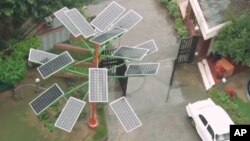Indian scientists have designed a new device they hope will solve one of the biggest problems with the use of solar energy.
They call the device a solar tree.
Solar trees have metal “branches” extending from a tall, central pole at different levels. Each branch holds a photovoltaic panel, also called a solar panel. These panels are flat surfaces that collect energy from the sun and turn it into electricity.
Daljit Singh Bedi is the chief scientist at the Council of Scientific and Industrial Research, or CSIR, in New Delhi, India. The CSIR laboratories are where the solar tree was designed.
Bedi says the shape of the solar trees makes it possible to fit more photovoltaic panels in a space than traditional systems do. This means less land would be needed to produce solar energy.
“It takes about four-square meters of space to produce energy which otherwise would have required 400 square meters of space,” he says. “So almost 100 times the space is saved, which as you know is very valuable.”
Buying land to develop roads, factories and other infrastructure has been a disputed issue in India. Disagreements often lead to protests by those forced to move. Some of the protests have turned violent.
Scientists believe the energy a solar tree collects will be enough to power five homes. The space-saving tree will make it easier to provide solar energy to homes in cities, they say. The trees will also take less space from farmers in rural areas.
Bedi says solar trees will collect more energy than normal photovoltaic panels on the tops of buildings.
“This design, it facilitates placement of solar panels in a way that they are exposed more towards the sun, ” he says. “And that way they are able to harness 10 to 15 percent more energy.”
India is the world’s third largest producer of greenhouse gases. The country promised to reduce its rate of greenhouse gas production at the United Nations Conference on Climate Change in Paris last year. India said, by 2030, it would reduce its rate of greenhouse gas production by one third over its levels in 2005.
The country’s promise depends heavily on increasing solar energy. India has set a difficult goal of getting 40 percent of its total energy from renewable sources by 2030. It also plans to reduce its use of coal.
The cost of photovoltaic panels has gone down in recent years. This has made solar power cheaper and easier to use. But, some people worry about the need to buy large areas of land for traditional solar energy collectors.
Amit Kumar is the senior director of the Energy and Resources Institute in New Delhi. The institute studies development in India and countries in the southern half of the world. Kumar says gaining access to land takes time and increases costs.
He adds that it is still not clear how useful these new developments in solar power technology are.
“[Only when] we put those [trees] on a large scale … will we be able to get that answer,” he says.
I’m Pete Musto.
Anjana Pasricha reported on this story for VOA. Pete Musto adapted it for Learning English. Mario Ritter was the editor.
We want to hear from you. Are scientists in your country developing new technology for renewable energy? What are some ways countries should try to use renewable energy sources? Write to us in the Comments Section or on our Facebook page.
_______________________________________________________________
Words in This Story
pole – n. a long, straight piece of wood or metal that is often placed in the ground so that it stands straight up
photovoltaic – adj. relating to the production of electricity by exposing two substances to light
panel – n. a flat piece of metal or plastic
facilitate – v. to make something easier
greenhouse gases – n. gases or pollution that causes the temperature of the Earth to raise
renewable – adj. restored or replaced by natural processes





